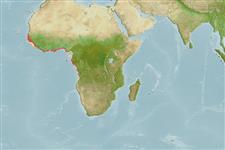Elasmobranquios (tiburones y rayas) (sharks and rays) >
Rhinopristiformes (Shovelnose rays) >
Rhinobatidae (Guitarfishes)
Etymology: Rhinobatos: Greek, rhinos = nose + Greek, batis, -idos = a ray (Raja sp.) (Ref. 45335).
More on author: Norman.
Environment: milieu / climate zone / depth range / distribution range
Ecología
marino; salobre demersal; rango de profundidad ? - 35 m (Ref. 114953). Tropical; 16°N - 17°S, 19°W - 13°E (Ref. 114953)
Eastern Atlantic: Gulf of Guinea to Angola.
Tamaño / Peso / Age
Maturity: Lm ? range ? - ? cm
Max length : 75.0 cm TL macho / no sexado; (Ref. 6497); common length : 60.0 cm TL macho / no sexado; (Ref. 114953)
Benthic and more or less stationary in inshore coastal waters. Feeds on fish and shrimps (Ref. 28587). Ovoviviparous. Females have litters of 2-3 pups. Males mature at ca. 46 cm TL, females at ca. 52 cm TL; birth size at ca. 15 cm TL (Ref. 114953).
Life cycle and mating behavior
Madurez | Reproducción | Puesta | Huevos | Fecundidad | Larva
Exhibit ovoviparity (aplacental viviparity), with embryos feeding initially on yolk, then receiving additional nourishment from the mother by indirect absorption of uterine fluid enriched with mucus, fat or protein through specialised structures (Ref. 50449).
Stehmann, M., 1990. Rhinobatidae. p. 23-27. In J.C. Quero, J.C. Hureau, C. Karrer, A. Post and L. Saldanha (eds.) Check-list of the fishes of the eastern tropical Atlantic (CLOFETA). JNICT, Lisbon; SEI, Paris; and UNESCO, Paris. Vol. 1. (Ref. 6497)
IUCN Red List Status (Ref. 130435: Version 2024-2)
Threat to humans
Harmless
Human uses
Pesquerías: escaso valor comercial
Herramientas
Special reports
Download XML
Fuentes de Internet
Estimates based on models
Preferred temperature (Ref.
123201): 24.8 - 28, mean 27.3 °C (based on 205 cells).
Phylogenetic diversity index (Ref.
82804): PD
50 = 0.5000 [Uniqueness, from 0.5 = low to 2.0 = high].
Bayesian length-weight: a=0.00295 (0.00151 - 0.00578), b=3.13 (2.96 - 3.30), in cm total length, based on LWR estimates for this (Sub)family-body shape (Ref.
93245).
Nivel trófico (Ref.
69278): 4.1 ±0.71 se; based on food items.
Resiliencia (Ref.
120179): Bajo, población duplicada en un tiempo mínimo de 4.5-14 años (Fec assumed to be <100).
Fishing Vulnerability (Ref.
59153): Moderate to high vulnerability (50 of 100).
Nutrients (Ref.
124155): Calcium = 49 [12, 214] mg/100g; Iron = 0.763 [0.193, 2.015] mg/100g; Protein = 19.1 [17.0, 21.1] %; Omega3 = 0.159 [0.069, 0.364] g/100g; Selenium = 36.7 [10.0, 102.6] μg/100g; VitaminA = 15.2 [7.1, 31.5] μg/100g; Zinc = 0.998 [0.498, 1.822] mg/100g (wet weight);
